Day 2 of a long weekend of tours today, and we made our way over to the Cley area. It was cloudy in the morning but brightened up to sun in the afternoon, although there was a blustery NW wind all day which took the edge off the temperature.
We started up on the Heath. It is always a good place to be in the morning, and particularly at this time of year. The Common Gorse is still in flower, looking stunning, and lots of Bluebells were out along the hedgerow. We stopped to admire the distinctive features of the native British Bluebell.
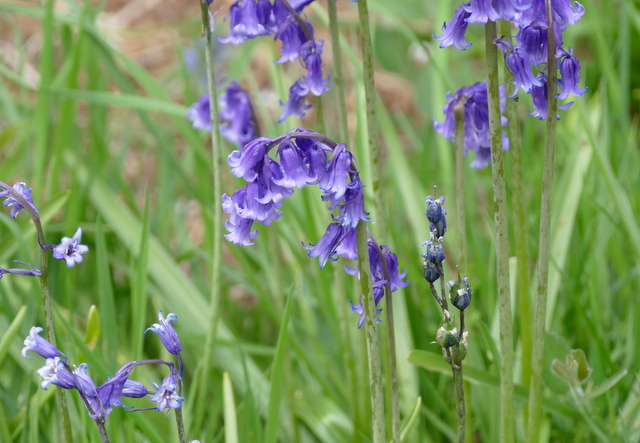 Bluebell – the distinctive native British species
Bluebell – the distinctive native British species
There were lots of warblers singing from the bushes. We c0uld hear a Garden Warbler close by, but it was tucked deep in the Blackthorn. We manoeuvred ourselves to try to see it, but as we did so a couple of dog walkers strolled straight in front of us and it went quiet. We could also hear Blackcap, Whitethroat, Willow Warbler and Chiffchaff.
As we walked past one of the newly cleared areas, a small bird flew up from beside the path and perched briefly on a gorse stump – a smart Woodlark. Unfortunately, it flew almost immediately but luckily didn’t go too far and we quickly got the scope on it. We could see there was a second bird with it, and this one differently marked, with pale scallops above rather than dark streaks. It was a juvenile Woodlark, following the adult. As we watched them for a time, it became apparent that there was a family group, two adults and three juveniles.
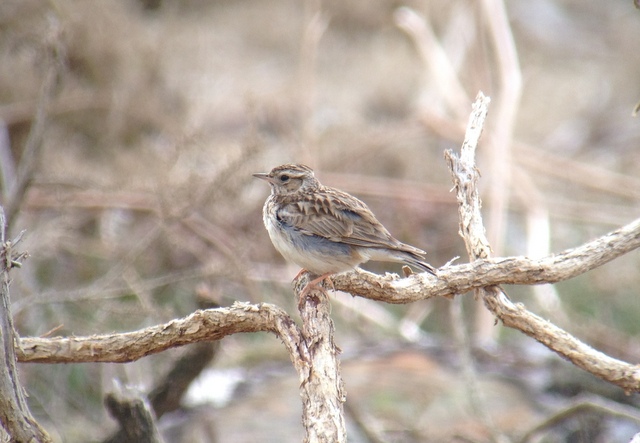 Woodlark – one of the adults perched up on a gorse stump
Woodlark – one of the adults perched up on a gorse stump
The Woodlarks were incredibly well camouflaged and very hard to see on the ground, unless you knew where they were. We watched them for some time, the adults picking around quietly amongst the dead branches and brash, the juveniles following or hiding in the tangles. Periodically, the adults would find some insects and would turn to feed one of the juveniles. It was a real privilege to watch them like this.
 Woodlark – the adult has just fed the juvenile and is off to find more food
Woodlark – the adult has just fed the juvenile and is off to find more food
Walking on, it didn’t take us long to hear our first Dartford Warbler, a male singing. We tracked down the thick clump of gorse he was hiding in, but he was keeping low in the blustery wind. We had a couple of glimpses of him darting between bushes, but he clearly wasn’t keen to show himself this morning. We decided to try our luck elsewhere.
A little further, and we picked up the faint purring of a Turtle Dove. It was some distance away at first and nigh on impossible to hear above the noise of the wind in the trees and cars driving past on the road beyond. Then it went quiet. We were just walking away when it started again, and we were able to track it down. What a wonderful sound, the purring of a Turtle Dove, and such a shame it is so rarely heard these days. We eventually got it in the scope and had great views of it perched unobtrusively, deep in a tree. Then a second Turtle Dove flew over and the first bird set off in pursuit. We were just leaving when the two of them flew back in and landed back in the trees again.
 Turtle Dove – purring from deep in the trees
Turtle Dove – purring from deep in the trees
Over the other side of the Heath, we could hear the distinctive calling of more Dartford Warblers, but once again they were tucked down out of the wind. Again, we had tantalising glimpses of birds flying between clumps of gorse and heather, but they would not show themselves – the wind seemed to be keeping them tucked down out of sight. We contented ourselves with watching a smart pair of Stonechats, perched rather more obligingly on the top of the gorse. We saw the female bringing food back, presumably to young in a nest somewhere nearby. A bright yellow male Yellowhammer also flew in and sat out for us on the top of a dead tree. A Green Woodpecker flew up noisily from the side of the path and off across the Heath.
By now, the weather was starting to brighten up, so we walked back across the Heath to try our luck again with the singing male Dartford Warbler we had glimpsed earlier. It didn’t take us long to track him down, but he was still hiding deep in the gorse. Then, as we rounded a corner, we surprised him sat in the open, right on the top. Unfortunately, he saw us and dropped back in before the whole group could see him. It was obviously not going to be a day for good long views of Dartford Warblers, given the wind, so we decided to move on.
Our next stop was at Cley. The scrapes on the reserve have been rather quiet recently, but we wanted to have a look at the flooded grazing marshes from the East Bank. This had been a productive spot last week. Grey Herons were coming and going from North Foreland wood, as were Little Egrets. One of the latter performed very nicely for us as we got up onto the bank.
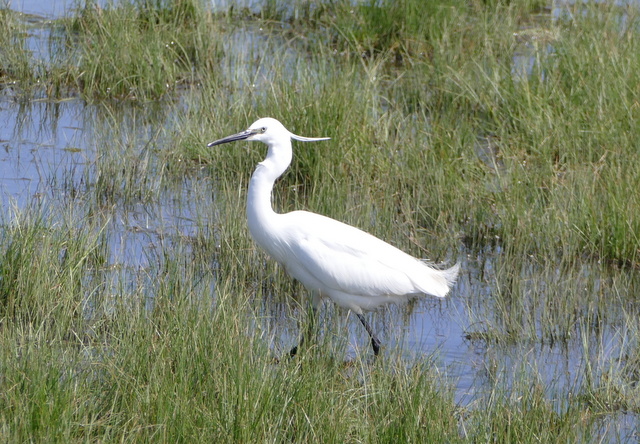 Little Egret – good views from the East Bank today
Little Egret – good views from the East Bank today
We stopped to admire a very smart male Lapwing, his iridescent upperparts shining in the sun, and several Redshank. It didn’t take us too long to find our target bird here, a delightful spangle-backed Wood Sandpiper. It was feeding very unobtrusively in the flooded grass, but at one point managed to irritate one of the Redshanks, which chased after it repeatedly. Still, it gave us a good size comparison between the two.
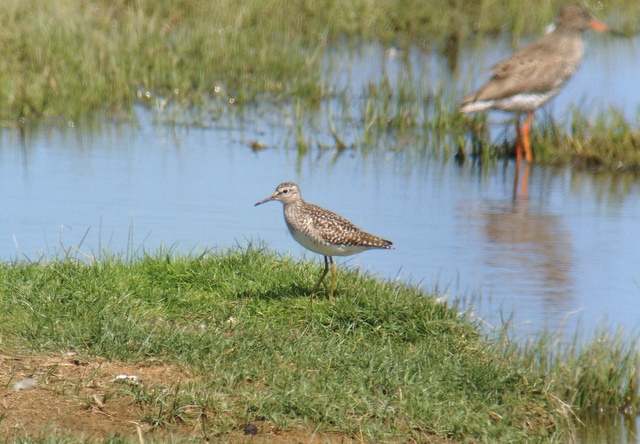 Wood Sandpiper – on the Serpentine, from Cley East Bank, today
Wood Sandpiper – on the Serpentine, from Cley East Bank, today
There were lots of other birds to look at here as well. The ubiquitous Avocets, but no less beautiful for it. Lots of Black-tailed Godwits further over towards the reeds. A Common Sandpiper flew in along the ditch in front of us and disappeared out onto the grazing marshes. There were ducks too – Gadwall, Shoveler, Mallard and lots of Shelduck.
Out on Arnold’s Marsh, we got a good look at a couple of Sandwich Terns out on the sand. There was a steady stream of them flying over, heading back towards the breeding colony on Blakeney Point. We added a few more waders to the day’s list – a couple of Ringed Plover, a Curlew and several Oystercatcher. However, the prize for the biggest surprise of the day goes to the female Goosander which flew in from the east, over Arnold’s Marsh and straight past us. Goosander is predominantly a winter visitor and May is a very late date for a straggler to be heading back.
 Goosander – this very late female was the complete surprise of the day
Goosander – this very late female was the complete surprise of the day
After the East Bank, we drove round to Salthouse and walked out along the Iron Road. There had been a Garganey here recently, but we couldn’t find it today. However, we did find an excellent selection of other birds. We picked up the 1st summer Little Gull out on one of the pools as soon as we got out of the car. It was sitting on the water, twirling round and picking at the surface, as they do. At one point, a Black-headed Gull landed behind it, highlighting just how little a Little Gull really is.
 Little Gull – a 1st summer bird by the Iron Road at Salthouse
Little Gull – a 1st summer bird by the Iron Road at Salthouse
While we were watching it, a couple of Yellow Wagtails flew overhead calling. One of them, a smart yellow male, dropped down in front of us, before disappearing into the grass. There were lots of Sand Martins feeding over our heads. Then, turning round to look behind us, there was a stunning summer-plumage male Ruff. As it preened, it even fluffed out its ‘ruff’ and crown feathers. A real stunner!
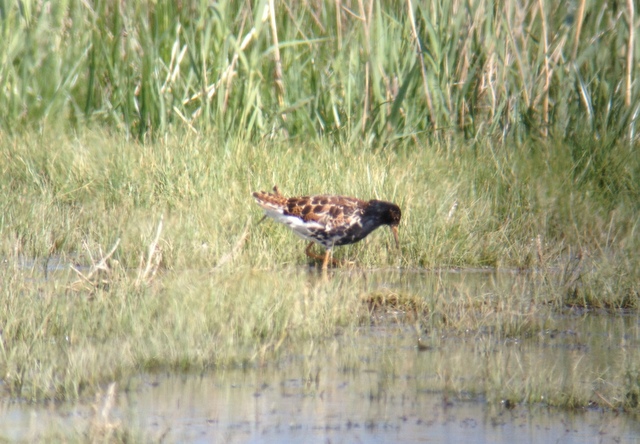 Ruff – a smart summer-plumage male
Ruff – a smart summer-plumage male
We still had time for one last stop, so we dropped in at Stiffkey Fen on our way back. There were a few waders there today – plenty of Black-tailed Godwit, plus singles of Common Sandpiper, summer plumage Dunlin and Little Ringed Plover. The highlight was a pair of adult Mediterranean Gulls which flew in to bathe.
It was high tide and the harbour was full of water. There were a few Brent Geese still milling around, swimming in the channel. We could see all the seals and Sandwich Terns out on Blakeney Point. A couple of Little Terns flew across the harbour closer to us. A small group of waders on one of the spits was pushed off by the rising water – as they flew across the harbour, we could see Grey Plover, a single Knot, Dunlin and lots of Turnstone. Then it was time to call it a day and head back.

















